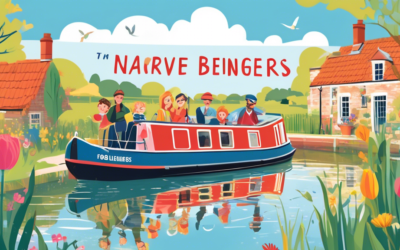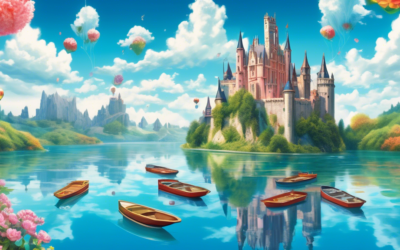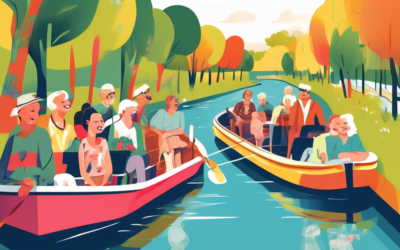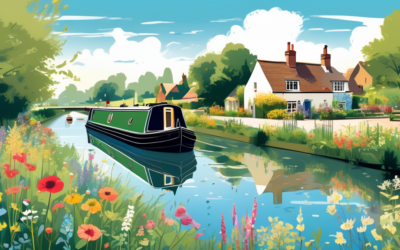Unveiling the Hidden History of Britain’s Waterways
The UK’s extensive network of canals and waterways has played a pivotal role in shaping the country’s history. These serpentine water corridors, which now predominantly serve leisure boating, fishing, and tranquil waterside walks, have a secret past filled with tales of innovation, community, and sometimes, even intrigue. As we embark on a journey through the historic and picturesque canals such as the Four Counties, Cheshire Ring, and Llangollen Canal, located in the north-west of England, let’s dive deeper into the captivating history that built Britain’s waterways into what they are today.
The Industrial Revolution: Canals as the Arteries of Commerce
It all began in the late 18th century with the dawn of the Industrial Revolution. Britain’s growing industries needed a reliable and efficient means of transporting goods. Roads were often in poor condition, and transporting by sea around the coast was lengthy and fraught with peril. Enter the canals – the revolutionary solution to Britain’s logistics nightmare. The construction of waterways such as the Bridgewater Canal, part of the Cheshire Ring, marked the beginning of what was to be a vibrant era of canal building across the country.
These canals were the arteries of commerce, carrying coal to fuel the burgeoning industries, cotton to the mills of Lancashire, and pottery from the famed kilns of Staffordshire. They were the high-speed highways of their day, slashing transportation costs and time, and fueling an unprecedented economic boom. Places like the Llangollen Canal, renowned for its picturesque aqueducts like the Pontcysyllte, became crucial trade routes linking the rural parts of North Wales and the industrial heartlands of England.
The Community Within: The Canal Folk
Canal life bred a unique community of people known as the ‘boatmen’ or ‘canal folk.’ These were the families who lived and worked on the narrowboats, plying their trade across the network of British waterways. Comprising hardy men, women, and even children, the canal folk formed a distinctive culture characterized by their colorful attire, beautifully painted boats, and a nomadic yet close-knit lifestyle. The waterways were not just a means of livelihood but a home and a way of life for these communities.
In the north-west of England, the canals became a melting pot for the canal folk. With routes like the Four Counties and Cheshire Ring serving as major arteries for commerce, they were often bustling with activity, offering a glimpse into the vibrant canal culture. It’s said that the canals had their own language, a mix of jargon and slang developed over years of isolation from mainstream society. This rich cultural tapestry is still celebrated today, with festivals and gatherings along the canals that pay homage to the unique way of life of the canal folk.
From Commerce to Leisure: The Transformation of British Waterways
The advent of rail transport and later, the motorway system, led to the gradual decline of canals as the primary mode of industrial transport. By the mid-20th century, many of the UK’s canals had fallen into disuse, with some sections becoming overgrown and impassable. However, the story of Britain’s canals took a positive turn thanks to the efforts of conservationists and boating enthusiasts who recognized the cultural and recreational value of these waterways.
Today, Britain’s canals have been revitalized as centers for leisure and tourism. The once-bustling trade routes are now frequented by holiday-goers on canal boats, eager to experience the tranquil beauty and rich history of these waterways. Companies like canal boat hire firms in the north-west offer visitors the chance to explore the scenic Llangollen Canal, the engineering marvel of the Cheshire Ring, and the tranquil countryside of the Four Counties on a leisurely paced narrowboat.
Exploring the Secret Past: A Journey Through Time
Traveling along the canals of the north-west, such as the Cheshire Ring or the Llangollen Canal, offers more than just relaxation and scenic beauty. It’s a voyage through Britain’s industrial heartland, exploring the remnants of the waterways’ storied past. From the awe-inspiring Pontcysyllte Aqueduct to the historic Anderton Boat Lift, these engineering landmarks stand as testaments to the ingenuity and determination of those who built the canals.
The canals also host a plethora of hidden gems, from the once bustling but now tranquil market towns that thrived because of canal trade, to secretive narrow passages originally built for transport but now providing serene retreats for wildlife. Even the traditional narrowboats themselves, with their intricate paintings and polished brass, tell a story of tradition, family, and craftsmanship.
For those interested in experiencing the unique blend of tranquility, beauty, and history that the British waterways have to offer, a canal boat holiday is an unforgettable adventure. Hiring a canal boat in the north-west not only supports the preservation of these historic waterways but also provides an opportunity to create new memories while reliving the secret past of Britain’s waterways.
Conclusion
The intricate network of canals that meander through the British countryside holds within its waters, locks, and towpaths a rich history waiting to be discovered. From their role in spearheading the Industrial Revolution to providing a conduit for unique communities and cultures, the waterways have evolved, yet they continue to capture the imagination of those who explore them. Whether you’re a history buff, nature lover, or simply in search of a peaceful retreat, the secret past of Britain’s waterways offers an enduring allure that spans the ages. So, why not set sail on a journey of discovery and experience the living history of the British canals?
Fancy a boat holiday – Check out Floating Holidays fleet for hire!






0 Comments